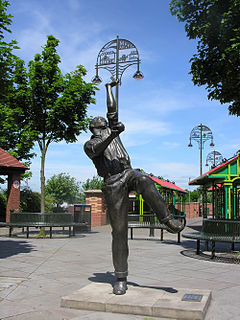Kirkby Woodhouse
Kirkby-in-Ashfield
|
|
|---|---|
 Statue of Harold Larwood in Kirkby Market Place |
|
| Kirkby-in-Ashfield shown within Nottinghamshire | |
| Population | 20,672 (3 Wards. 2011) |
| OS grid reference | SK5056 |
| District | |
| Shire county | |
| Region | |
| Country | England |
| Sovereign state | United Kingdom |
| Post town | Nottingham |
| Postcode district | NG17 |
| Dialling code | 01623 |
| Police | Nottinghamshire |
| Fire | Nottinghamshire |
| Ambulance | East Midlands |
| EU Parliament | East Midlands |
| UK Parliament | |
Kirkby-in-Ashfield is a market town in Nottinghamshire, England, with a population of 25,265 (according to the 2001 National Census), falling to 20,672 for the total of the 3 Ashfield Wards taken at the 2011 census. It is a part of the Mansfield Urban Area. The Head Offices of Ashfield District Council are located on Urban Road in the town centre.
Kirkby-in-Ashfield lies on the eastern edge of the Erewash Valley which separates Nottinghamshire and Derbyshire. Kirkby, as it is locally known, was originally a Danish settlement (Kirk-by translates as 'Church Town' in Danish) and is a collection of small villages including Old Kirkby, The Folly (East Kirkby), Nuncargate and Kirkby Woodhouse. It is mentioned in the Domesday Book and has two main churches: St Wilfrid's, a Norman church, which was gutted by fire on 6 January 1907 but quickly re-built to its former glory; and St Thomas's, built in the early 1910s in neo-gothic style.
Kirkby-in-Ashfield was once an important centre of coal mining and railways in west Nottinghamshire, with three active coal mines and several railway junctions. The former Mansfield and Pinxton Railway from the Erewash Valley Line was joined here by the later Midland Railway line from Nottingham. The Great Central Railway main line passed to the south-west side of the town and had a double junction with the Great Northern Railway Leen Valley Extension line to Langwith Junction and the Mansfield Railway to Clipstone.
...
Wikipedia

